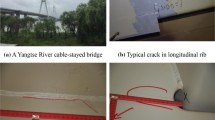Abstract
Fatigue has gradually become a serious issue for orthotropic steel deck used for long-span bridges. Two fatigue effects, namely number of stress cycles and equivalent stress amplitude, were introduced as investigated parameters in this paper. Investigation was focused on their relationships with traffic volume and ambient temperature by using 7-months fatigue monitoring data of an actual bridge. A fatigue analytical model considering temperature-induced changes in material property of asphalt pavement was established for verifying these relationships. The analysis results revealed that the number of stress cycles and equivalent stress amplitude showed a linear correlation with the traffic volume and ambient temperature, respectively, and that the rib-to-deck welded joint was much more sensitive to the traffic volume and ambient temperature than the rib-to-rib welded joint. The applicability of the code-recommended model for fatigue vehicle loading was also discussed, which revealed that the deterministic vehicle loading model requires improvement to account for significant randomness of the actual traffic conditions.
Similar content being viewed by others
References
Xiao Z G, Yamada K, Ya S, et al. Stress analyses and fatigue evaluation of rib-to-deck joints in steel orthotropic decks. Int J Fatigue, 2008, 30(8): 1387–1397
Pfeil M S, Battista R C, Mergulhao A J R. Stress concentration in steel bridge orthotropic deck. J Construct Steel Res, 2005, 61(8): 1172–1184
Kiss K, Dunai L. Fracture mechanics based fatigue analysis of steel bridge decks by two-level cracked models. Comput Struct, 2002, 80(27–30): 2321–2331
Tsakopoulos P A, Fisher J W. Full-scale fatigue tests of steel orthotropic decks for the Williamsburg Bridge. J Bridge Eng, 2003, 8(5): 323–333
Xiao Z G, Yamada K, Inoue J, et al. Fatigue cracks in longitudinal ribs of steel orthotropic deck. Int J Fatigue, 2006, 28(4): 409–416
Choi J H, Kim D H. Stress characteristics and fatigue crack behaviour of the longitudinal rib-to-cross beam joints in an orthotropic steel deck. Adv Struct Eng, 2008, 11(2): 189–198
Ya S, Yamada K, Ishikawa T. Fatigue evaluation of rib-to-deck welded joints of orthotropic steel bridge deck. J Bridge Eng, 2011, 16(4): 422–499
Battista R C, Pfeil M S, Carvalho E M L. Fatigue life estimates for a slender orthotropic steel deck. J Construct Steel Res, 2008, 64(1): 134–143
Sim H B, Uang C M, Sikorsky C. Effects of fabrication procedures on fatigue resistance of welded joints in steel orthotropic decks. J Bridge Eng, 2009, 14(5): 366–373
Aygül M, Al-Emrani M, Urushadze S. Modelling and fatigue life assessment of orthotropic bridge deck details using FEM. Int J Fatigue, 2012, 40(1): 129–142
Connor R J, Fisher J W. Consistent approach to calculating stresses for fatigue design of welded rib-to-web connections in steel orthotropic bridge decks. J Bridge Eng, 2006, 11(5): 517–525
Siriwardane S, Ohga M, Dissanayake R, et al. Application of new damage indicator-based sequential law for remaining fatigue life estimation of railway bridges. J Construct Steel Res, 2008, 64(1): 228–237
Kwon K, Frangopol D M. Bridge fatigue reliability assessment using probability density functions of equivalent stress range based on field monitoring data. Intl J Fatigue, 2010, 32(8): 1221–1232
Wang Y, Li Z X, Li A Q. Combined use of SHMS and finite element strain data for assessing the fatigue reliability index of girder components in long-span cable-stayed bridge. Theoretical Appl Fracture Mech, 2010, 54(2): 127–136
Li Z X, Chan T H T, Ko J M. Fatigue analysis and life prediction of bridges with structural health monitoring data-Part I: Methodology and strategy. Eng Struct, 2001, 23(1): 45–53
Deng Y, Ding Y L, Li A Q. Fatigue reliability assessment for bridge welded details using long-term monitoring data. Sci China Tech Sci, 2011, 54(12): 3371–3381
Li A Q, Ding Y L, Wang H, et al. Analysis and assessment of bridge health monitoring mass data-Progress in research development of “Structural Health Monitoring”. Sci China Tech Sci, 2012, 55(8): 2212–2224
Ding Y L, Zhou G D, Li A Q, et al. Thermal field characteristic analysis of steel box girder based on long-term measurement data. Int J Steel Struct, 2012, 12 (2): 219–232
Souza F V, Castro L S. Effect of temperature on the mechanical response of thermo-viscoelastic. Construct Build Mater, 2012, 30: 574–582
Zha X D. Temperature adjustment for back calculation modular of asphalt pavement (in Chinese). Highway, 2002, (6): 51–53
Li H T, Huang W. Study on deck surfacing of trail bridge for Runyang Bridge (in Chinese). J Highway Transport Res Development, 2005, 22(4): 76–78
Author information
Authors and Affiliations
Corresponding author
Rights and permissions
About this article
Cite this article
Song, Y., Ding, Y. Fatigue monitoring and analysis of orthotropic steel deck considering traffic volume and ambient temperature. Sci. China Technol. Sci. 56, 1758–1766 (2013). https://doi.org/10.1007/s11431-013-5235-0
Received:
Accepted:
Published:
Issue Date:
DOI: https://doi.org/10.1007/s11431-013-5235-0




